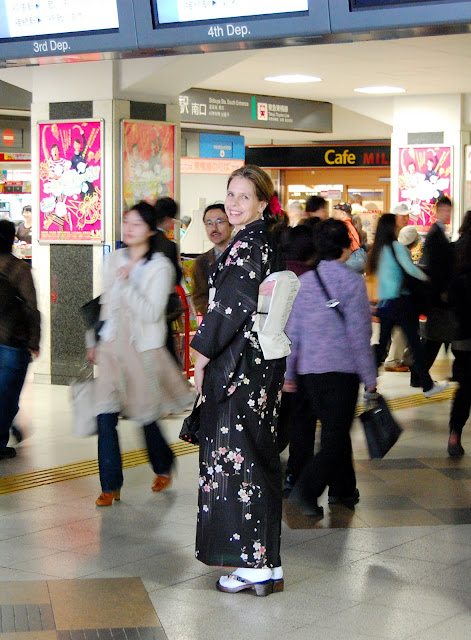5/29/2011
Grocery Shopping - 食品買い物
People often ask me: 'do you wear kimono every day?" And I have to answer: "no, not every day." And the reason is this... my life is busy, and sometimes kimono doesn't always work for a modern, urban woman's lifestyle. For example - some days I work at a different location from my home, stop off and do yoga, then meet up with some friends in a smokey izakya (Japanese bar). Kimono works well in the beginning of the day, but as the day goes on, it gets more complicated; the yoga studio is small - where would I fold my kimono before yoga class begins, the bar is smokey - the kimono would have to be cleaned before I wore it again. So I have to answer: "no, not every day."
「毎日着物を着ているの?」とよく聞かれます。すると、「いいえ、毎日は着ないね」と答えなければなりません。その理由は次の通りです。私は忙しい毎日を過ごしていまして、着物はモダーンで都会的な女性のライフスタイルと会わない場合もあるからです。時々外で仕事をしたり、ヨガのレッスンにも通ったり、夜には煙りっぽい居酒屋で友達と会ったりもしています。このようなスケジュールの日には、着物はお昼ぐらいまで邪魔にならず大丈夫ですが、その後から難しくなってきてしまいます。ヨガのスタジオの着替え質は狭くて度々着物を畳んでまた着付けしなければならないこととか、煙っぽいところにいると次着る前に洗わなければならないことなど、色々な問題があります。このため、「毎日は着ないね」と答えざるを得ない。
And when I meet women in kimono, I ask them the same question. And then if they say yes, I ask them "even to the grocery store?" I don't know why I have fixated on this, the most mundane of chores, but it's my test. Firstly, you have to leave the house. There are two safe bets on what occassion works for kimono; you are going 'out' and it's occassion wear or you put it on every morning like most people put on their clothes (without thinking about it) and that's it. But for some reason, this idea of wearing it grocery shopping marks the test. And most women answer: "no, not for grocery shopping."
私も着物を着ている女性に合うと同じ質問を聞きます。そしてもし答えが「はい」だと、「スーパーにも着ますか?」と聞く癖があります。なぜかこの場面がいつも頭に浮かぶのです。私の中のテストかな。まずは、家を出なきゃいけない。着物姿で出かける理由は大体2つあります:特別なイベントのためか、普段着で着ている人はいつも通りに。しかしなぜか、スーパーまでにも着物姿で行く人は私の中のテストに合格します。でも、ほとんどの女性は「いや、スーパーには着ないな」と答えます。
So I decided to try it. I was out, I was in kimono, and it was my grocery day. Kimono is great for shopping - but it's the after shopping part where kimono doesn't quite work. Luckily, my photographer (my husband) also carries the bags!
なので、やってみよう!と思いました。食品買い物の日に、着物を着て、スーパーへ行きました。買い物中、着物は良かったですが、その後から少し難しくなりましたな。でも、(私の主人でもある)写真家のおかげで家まで運ぶことは何とかなりました!
5/24/2011
Kimono Seasons - 着物の季節
I had it wrong.... I still can't get the kimono calendar right. I was so looking forward to wearing yukata (a lightweight, cotton kimono) which I thought I could starting in June. But...I had it wrong. Currently I wear a double-layer nagajuban (the under kimono) and a double-layer kimono. Now that it's May, I can change to single-layer nagajuban. And I can change to a single-layer kimono in June. I can't wear yukata until July and August. But it is 29°C today - I don't know how I will make it to July!
また間違えてしまいました!私、着物のカレンダーはまだマスターできていないな。浴衣を着れるようになるのが楽しみすぎで、6月ぐらいから着れるのかと思っていました。しかし、そうは行きませんよね。今までは二重の長襦袢と二重の着物を着ていました。5月になってから1枚の長襦袢にチェンジしました。そして、6月になったら1枚の着物にチェンジできます。でも浴衣は7月か8月まで我慢だ!なのに今日は既に29°Cです。いったいどうすれば7月まで持てるのかしら!
5/21/2011
At the photography museum - 写真の博物館で
In case you hadn't noticed, one of my other passions is photography! Tokyo has an amazing Photographic museum and last week we had a chance to visit! I tried to match the woman in kimono and become part of the picture!
皆様ご存知でしたか?私のもう一つの趣味はフォトグラフィーです!東京に素晴らしい写真の博物館がありまして、先週行く機会ができました!写真の中の着物女性と馴染もうとしてみました!
And then we walked around the gardens near the museum. People keep asking about the situation now in Japan, and it is improving slowly but surely. The nuclear disaster is the thing that most affects Tokyoites, and that we take day-by-day.
そして博物館の辺りのガーデンも歩き回りました。外国の友達からは、今の日本の状況についてよく聞かれますが、だんだん上達してきていますよね。東京人にとっては原爆が第一の不安だと思いますが、1日づつですね。
The radiation levels in the city seem to be reducing and, as we enter typhoon season, most storms and strong wind will continue that trend as they move from south to north, or west to east.
町の放射濃度も下がっているそうです。梅雨に入ってからも、ほとんどの強い風は南から北へ、東から西へと動くそうなので、より下がるだろう。
And Japan is re-examining their nuclear power plans and plants, and looking forward to re-creating themselves as leaders in the 'clean energy' fields. Lots to smile about!
そしてこれから日本は発電装置をまた調査して、世界中に「クリーンなエネルギー」を促進するよう頑張って行くそうです。笑顔の理由はたくさんありますね!
5/14/2011
My Japan Exhibition - My Japan 写真の展示会
This week was the My Japan Exhibition. Time Out Tokyo tweeted: 'What #quakebook did with words, 'My Japan Exhibition' does with pictures.' In an effort to raise money for relief efforts of the Great East Japan Earthquake, My Japan solicited photos of Japan from around the world. Then, through Facebook, they asked people to vote for their favourites. They picked the top 50 photos that showed hope, love, inspiration, beauty, nature and everything that makes Japan what it is and held an exhibition.
今週は、My Japan の展示会でした。Time Out Tokyo は 'What #quakebook did with words, 'My Japan Exhibition' does with pictures.'とtweet しました。関東大地震の被害に寄付する資金を集めるために、My Japanは世界中から写真を請い求めました。そして facebook を通し、世界中の人々が参加する投票を行ったのです。一番人気の出た、希望、愛、インスピレーション、美しさ、自然、つまりこの国を作るものを表す、トップ50枚の写真を展示に出品しました。
Visitors included photographers, photo buffs and philanthropists (as all photos were for sale) with the proceeds going to an NGO called JEN. The exhibit will now hit the road and visit London and other locations (tbd). You can see the top 50 here.
お客様の中には、写真家、慈善家(展示に出た写真は販売されています)、がたくさんいました。すべての利益は JEN という NGO に寄付されるのです。次は、ロンドンなどで展示する予定も調整中だそうです!展示されたトップ50はここで見れます。
5/12/2011
Reflections on Kimono − 着物について
The Year in Kimono is now in it's 5th month! FIFTH month! I can't believe how fast time flies! I love it, I can dress myself (including Otaiko obi tying) so of course, now is time to maybe feel a little discontent. Now, don't get me wrong... I'm not complaining, it's just... I'm having trouble inserting the 'me' into the kimono. My Japanese friend's keep saying, just 'do it' - wear how you want, adapt how you want, etc. But for some reason it feels wrong. It feels like, as a 'visitor' into the hallowed halls of kimono, I can stay and visit but not alter anything. I'm just a guest.
今月で、「着物の一年」のスタートから5月目です!あっという間に時間が過ぎちゃいましたね!一人で着付けをできるようになりましたし、太鼓帯も結べるようになりました。とても嬉しいです。なので、そろそろ一つの不満を言っても大丈夫かしら?文句を言うつもりは全くないのですが、ただ・・・ 着物着ている時、「自分らしさ」をどのように表せられるのかがまだイマイチなのです。日本人のお友達は、大丈夫だから自分が着たいように着ればいいよ、自分に合わせて着てご覧、と言ってくれますが、どこか、なにかがちょっと違う気がしてしまうのです。「着物」という世界の中に私は単なるゲストで、訪問することは大丈夫ですが何も変えてはいけない、という感じがします。
 |
| photo: TokyoFashion.com |
もし、この「着物の世界」が自分の文化のものであり、それほど伝統に根強くなければ、私もこういう風に着たいな。以前やってみたように長襦袢抜きで着たいです。
 |
| photo: TokyoFashion.com |
帯も調節してみたいなぁ(このベルト大好きです!)。帯を結ばなくてもいいなら着付け時間も減らせるし、もっともっと自由になれる!
 |
| photo: TokyoFashion.com |
そしてたまには、自分の靴も合わせて履きたいな。TokyoFashion.com が取り上げた、21歳の学生、ヒイロさんみたいに。ヒイロさんのブログはこのリンクで見れます。
さて、皆様はどう思いますか?自分のアクセアイテムなどで日本の伝統の着物を調節してみてもいいかしら?むしろ、私には調節できるのかしら?皆様どうですか、ちょっとおこがましく見えてしまうかな?
5/11/2011
留袖 - Tomesode
「留袖」というものを先生が初めて説明してくださったときに、私は得意の想像力を働かせすぎて、勝手に解釈ミスをしてしまいました。留袖とは「羽を切る」ようなものだと。
なぜそう思い込んだかというと、結婚した女性は、未婚の頃のように美しい羽をはばたく振り袖を捨て、自由なその羽を留めなければならない時期が来たという意味なのだろう思ったのです。
でも、それが私の完全な妄想だと気づいた時には、自分で笑ってしまいました。実はそんな深い意味はなく、単に、主婦となったらしなければならない家事の邪魔にならないようにという実用的な理由で袖の長さを短くするだけだったんですね。まったく西欧的な誤解ですよね!
実際に私が留袖を着られる機会は、なかなかないと思います。だから着付けレッスンで着られてとても嬉しかったです。
着物と袋帯にもちゃんと意味があるという事実にも感心しました。二倍の幸せを招くために二重である。そして、何度でも、また何代にもわたって繰り返して着る。こういうものはカナダにありません。カナダでは、結婚式にお嫁さん以外白いドレスを着てはいけない、というのがたった一つの規定です。新郎新婦の母親だけが特別なドレスを着て、それでもウェディングドレスと同じく一回しか着ないものです。
---
When my teacher first explained Tomesode (the formal kimono worn by married women) to me, I misunderstood the explanation and thought the sleeves were ‘wings’ and that the tomesode was ‘clipping wings’ rather than the two kanji meaning "to fasten" (留) and "sleeve"(袖). My mind went on a whole story about how married women do need to clip their wings, that they aren’t the beautiful butterflies they were in their furisode (the formal kimono for unmarried women has long sleeves - that almost touch the ground) before they got married. But that’s my western misinterpretation. I giggled when I realized that it was far less sinister and much more practical; sleeves needed to be shortened to be more practical in the kitchen.
I don’t think I will ever get a chance to wear tomesode (it should be worn at the wedding of your sister, or children - neither of which I have), so I loved the fact that I had the opportunity to wear one at kimono school. To further celebrate the occasion in which it is worn, the kimono and the furkuro obi are full of meaning as well, both are double lined to bring double happiness.
And the best part about tomesode is it is worn again and again. It is the formal dress for a married woman. You only need one. We don’t have this in Canada. Our only stipulation is that to a wedding you can’t wear white, as it detracts from the bride. And the mothers of the bride and groom are the only ones who usually wear special dresses, but these (like the wedding dress) are only usually worn once and rarely handed down.
- originally published in a/r/e/c/o/l/e monthly magazine, June Issue. アレコレ月刊の6月号に出版
5/06/2011
In Shibuya - 渋谷で
As this project has progressed, you might have noticed that the pictures improved. This is because I bought a new camera. At the beginning of this project I was using a point-and-click Olympus, but as I started to want to move beyond my neighbourhood, I realised I needed something with a zoom.
このプロジェクトのスタートから、写真がだんだんきれいになったことを気付きました?新しいカメラを買ったからです。始めた頃は普通のオリンパスカメラを使っていましたが、自分の近所から範囲を広げようとすることで、良いズーム機能のあるカメラが必要だと気付きました。
And a faster shutter speed. So we could catch photos in the busiest of places (like Shibuya station). I now use a second-hand Nikon D40 (I call it my new 'old' camera!)
シャッタースピードも早くて。そうしたら、(渋谷駅みたいに)忙しいところでもきれいな写真を撮れます。今は、中古のニコンD40カメラを使っています‐‐私の新しい古いカメラと呼んでいます!
So, at four o'clock in the afternoon, Taiko (drum) knot firmly in place, we held an impromptu photo shoot at one of the busiest train stations in the world.
太鼓結びもしっかりした格好で、夕方の4時ぐらいに世界の一番忙しい駅の中の一つで、即座の撮影を行いました。
5/02/2011
Tying Taiko - 太鼓結び
As I mentioned in an earlier post - my first two months of kitsuke (kimono wearing lessons) I learned about kimono types and perfected getting dressed on my own (now down to less than 15 minutes!). But most of those lessons ended with me still wearing a Hanhaba (half width) obi - which I can tie quickly and painlessly and still get dressed in about 15 minutes. Time to start perfecting the Taiko (named for the shape of the famous Japanese drum) knot on a Nagoya (full width) obi.
着付けレッスンを始めて最初の2カ月は、着物の種類や自分で着付けをするということを中心に勉強していました。おかげで今は15分以内に着付けを終えられます!が、それは半幅帯を着けるときだけです。今度の課題は、名古屋帯を太鼓結びにすること!
Not only is the obi wider, it's tied and arranged mostly behind your back (here my sensei leads and I try to follow).
この帯は幅がもっと広いだけではなく、主に後ろで形を作るのです。先生に従って頑張っています!
But it has more things attached to it, the least of which is the flair (decorative pieces) such as the Obiage (a scarf-like piece of cloth - seen here in pink) and the Obijime (the decorative rope).
しかも、帯揚げ(スカーフようなピンクの生地)や帯締め(きれいな紐)など、色々な物も付いてくるのです。
However, when it's done, there's no denying that it creates a more polished look. Not to mention a huge sense of pride!
しかし、完成はきちんとした雰囲気に整えてくれますよね。プライドも満々で!
Subscribe to:
Comments (Atom)



















